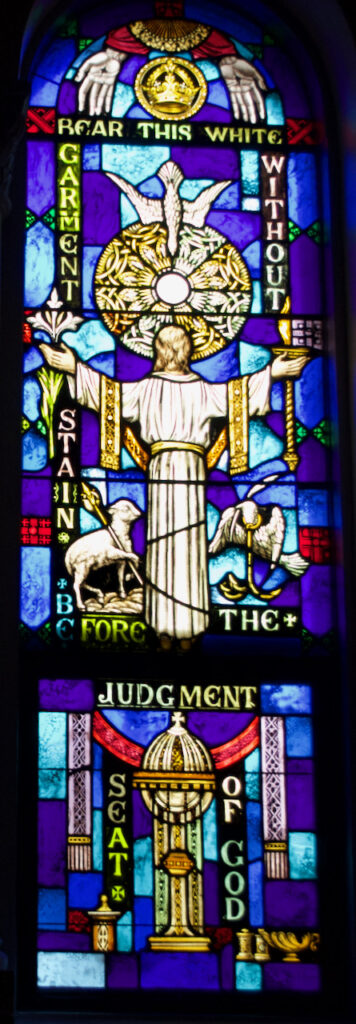
This is a continuation of the previous post about the windows in the Baptistry.
During the celebration of the Sacrament of Baptism, the person being baptized, the parents (if it is a child), the godparents, and all present are asked to renounce Satan, his works and his empty promises. These prayers are accompanied by a prayer of exorcism and anointing with the Oil of Catechumens, liberating the person from the power of Satan.
The action of casting out Satan is powerfully illustrated in this baptistry window. Satan is depicted on his knees, with the flames of hell around him. His contorted hand suggests his weakness in this moment. The zig-zag lines convey the power that has cast him out and their origin is the nail wound in the hand of Jesus, for it is the power of the cross that overcomes Satan’s strength. The wounded hand pours this power out upon the candidate being baptized. The Holy Spirit is also present in this moment, and the circle around the dove suggests God the Father. Beside the circle are the alpha and omega, a sign for Jesus, intricately decorated. All present at the Baptism profess their faith in the Father, Son, and Holy Spirit.

In the next window the newly baptized is seen in the white garment, with a gold sash, perhaps representing the divine life in which he now participates. It is rich in symbolism conveying the reality of the effect of the sacrament in a person’s life. “The white garment symbolizes that the person baptized has “put on Christ,” has risen with Christ.” (CCC 1243) It is also a sign of his or her Christian dignity. The Rite of Baptism instructs the newly baptized to bring the garment, “..unstained, into eternal life.” (USCCB, 2020, p. 40 ) In the bottom pane of the window is the closed baptismal font, reminding us that the character of our Baptism remains in our soul forever.
In the hands of the baptized are a candle and a lily. The candle is given with the words, “Receive the light of Christ.” (USCCB, 2020 p. 40 ) The godparents, parents, and community present are charged with assisting the person to keep it “…burning brightly”. (USCCB, 2020, p. 41). The lily has three flowers symbolizing purity, innocence and immortality. These graces of Baptism come from the wounded hands of Jesus, extending from the sleeves of a red robe at the top of the window. REd symbolizing his suffering and death, the source of the Sacrament. The crown within the circle might represent Jesus kingship, everything having been given over to Him by His Father.
When a person is baptized and received into the church at the Easter Vigil, he or she receives all three Sacraments of Initiation: Baptism, Confirmation, and Holy Eucharist. The dove symbolizes the Holy Spirit received in Confirmation and the Eucharist is symbolized by the white Host, with the beautiful circle surrounding it, as we often see the Host surrounded by the monstrance during Adoration of the Blessed Sacrament. The Lamb of God also connotes the Eucharist. In this image the lamb is holding a staff crowned with a fleur-de-lis, symbol of the Trinity. The bird with the olive branch recalls the waters of Noah which foreshadowed the waters of Baptism, which was in God’s plan from the beginning. The anchor symbolizes the Church and community of faith into which the person has been baptized. It suggests hope, stability and safety.
As we reflect on the realities of the Sacrament illustrated in these two windows, let us consider how we help and encourage one another in letting the light of Christ shine brightly in our lives. Let us also consider how we, as the baptized community of faith help each other to “put on Christ” every day and share His love with the world.
References
Catholic Church. (1994). Catechism of the Catholic Church. Vatican City: Libreria Editrice Vaticana.
United States Conference of Catholic Bishops. (2020) The Order of Baptism for Children. Collegeville, MN: Liturgical Press.